Have your briefings become a “one-size fits all solution serving as a repository for redundant verbal crew crosschecks of highly automated, highly reliable systems”?
If the briefings at your operation sound a bit like that, then read on for some suggestions on ways you might fix ‘em up…
First up, a reminder of why we brief?
We brief because we want to try to identify anything that might mess up our flight up, and work out how to stop it before it gets the chance to. That includes identifying anything silly the other person might be planning on doing, so it’s good to include them on it too.
The word ‘brief’ actually means a bunch of things – of short duration, a set of instructions, underwear – which all seem fairly appropriate to what we are using it for (underwear being the inner line of support, defence and protection when things get really scary…)
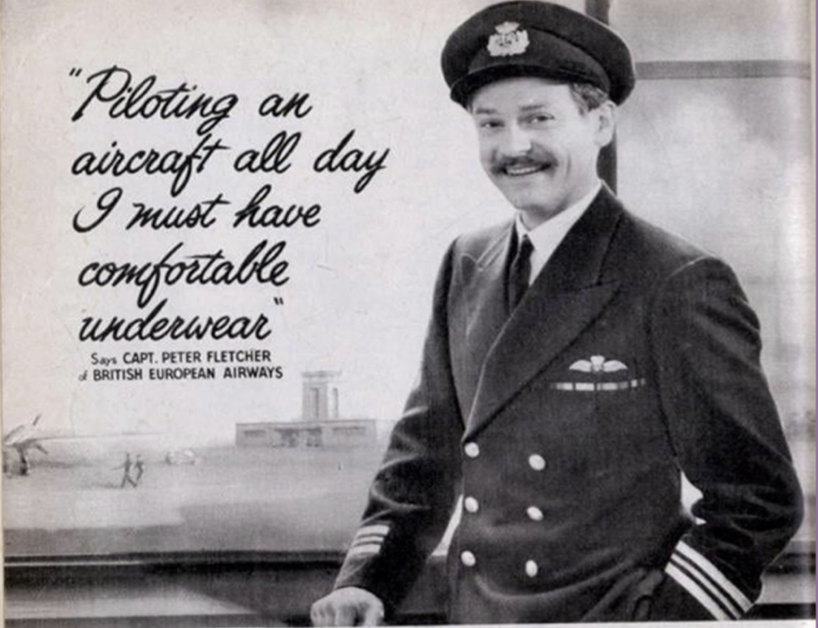
Briefs are important.
So, what do we want our brief to contain?
We want our briefing to cover any threats and possible errors we spot out in the big wide world, and we also want it to involve some ideas on how to mitigate against these.
If you’re not sure then we find this list handy. If you say yes to any of these, talk about it:
- Does something feel scary?
- Does something look hard?
- Does anything seem weird?
- Is there a chance you’ll do something stupid?
And what don’t we want it to contain?
- Too much waffle.
- Too much explaining ‘how to fly’ to the person next to you (they probably know already).
- Stating the obvious or listing SOPs that you both know anyway.
- A plan for absolutely everything possible, including what to do if a Pterodactyl attacks. It just isn’t necessary.
Any of these will definitely result in your co-pilot shutting off and not listening even to the bits you do need them to hear.
So how do we do this?
Well, we can play a sort of ‘I-Spy’ game.
“I spy with my little eye, something beginning with M.”
“Merr.. Muu…Maaa…Mountain?”
“Yes, one point to the co-pilot!”
Or we can be a little more structured about it and follow a method which helps remind us of the big stuff to look out for. We have one to share, which is summed up in the nice tidy acronym: C-TWO-F-U. You might like it, you might not. But here it is.
C is for Charts
We probably want to take a fairly close look at these since they are what we need to follow, and they often lay out some of the big threats for us.
Taxi charts, arrival, departure, approach charts… A quick confirmation of the date to make sure it is the valid one is important, but after that really you are looking to do two things here:
- Look for anything unusual, threatish or dangerous on the charts. A lot of them include some really useful little notes actually.
- It is no good briefing a chart to death if it isn’t what you then fly. A confirmation that what you’re talking about is what you’ve programmed into the box (tracks, altitudes, speed constraints etc) is also important. Think of it as briefing your airplane too.
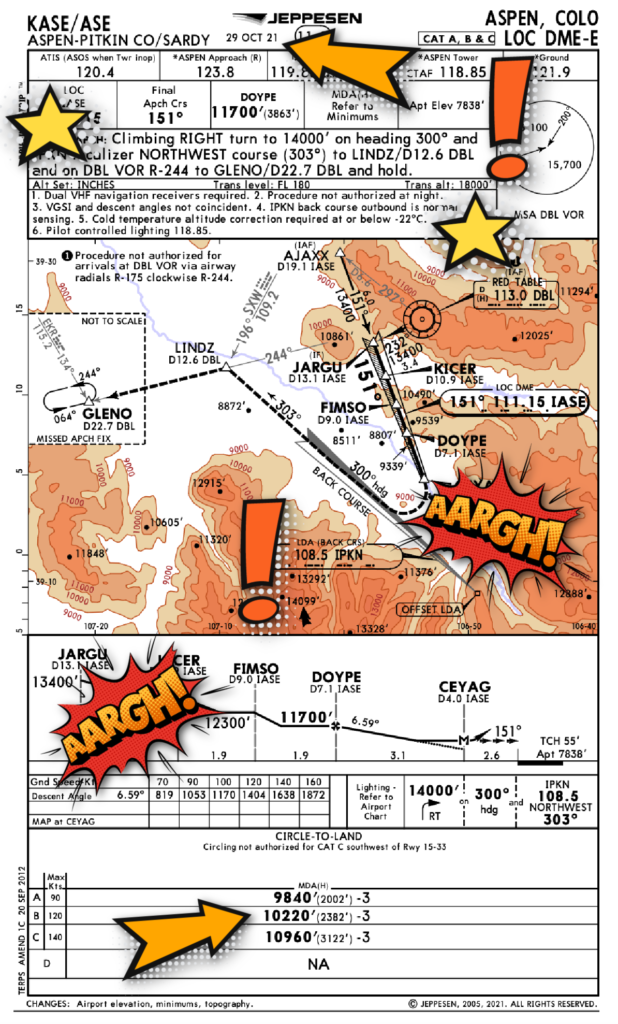
To be honest, a bad example because everything on here is horrifying and worth pointing out.
T is for Terrain
Why does terrain get its own section? Well, because it’s big and if you get it wrong it’s nasty. C-FITs (Controlled Flight Into Terrain) are one of the biggest common accident types. From 2001-2020, CFIT accidents were the second largest category (21%) behind LOC-I (33%).
So, take a look at the terrain and more importantly what it might do to you.
- Turbulence.
- Weird turns required.
- Mega RODs (after you’re over it).
- Constraints on the way out. Or the way in for that matter.
- High elevation.
- Climb performance problems.
- Missed approach gradient problems.
But remember – don’t just scare the pilot next to you with a list of horrifying ‘death threats’ – try to explain how you reckon you should deal with it all as well.
W is for Weather
Another big one. Review it for that specific flight. No point talking about wind shear if it’s a lovely calm day – what would be the point?
It isn’t a lovely calm day? Well, whatcha gonna do about it? Which heading do you want to avoid that mega storm? Do you maybe want to run the performance again since the runway is covered in ice?
O is for Operational
You might have covered some of this earlier so don’t go re-listing it all again. Here are some ideas though:
- Aircraft: Talk about any MELs, CDLs, random or specific procedures you might have to consider for that flight.
- Airport: Are there any NOTAMs, specific procedures (Noise Abatement Procedures perhaps?), altimeter setting procedures (metric, or low transition alts)?
- Crew: Talk about yourselves, any threats there? I like to mention things like how irritable I might be because I didn’t have lunch.
- How you’ll fly it all: Share your autopilot usage plans and stuff like that.
- Performance: A good time to check this and make sure you’ve done it, and you’ve set it up in the box properly in terms of speeds, flex, all that stuff.
F is for Fuel
Check you have what you wanted and check it’s still what you need.
U is for yoU?
I added this in because I thought ‘FU’ sounded funny. Really this is just a last “any questions?” Or a “anything I’ve missed that yoU can think of?” moment.
How do we brief?
If we do the briefing out loud then it definitely helps – few of us are mind readers. If you make it interactive – well then now you’ve got two pilots both thinking about it and working it out together. Bonus.
I said it before, a quick reminder again – a good threat based briefing is about identifying threats specific for that day, for that flight, and then coming up with strategies for preventing them.
What?: A steeper than normal approach gradient? Ok, great, spotted it.
Why?: That could be a threat to our stabilisation and speed control. So what to do about it?
How?: Configure early, get the PM to keep an eye on that speed, be prepared to go-around if it becomes unstabilized.
Any other methods?
Airbus have recently changed their recommended briefing method and it is now super simple. All SOPs, standard stuff, checks etc are out, and the briefing now follows this format:
PM: Begins the briefing with the general plan – runway, SID, stop altitude and any extra fuel
PF: Talks through the general strategy – how to get to the runway (including any taxi hotspots), how to fly the SID (use of automation), any Notams or operational stuff to affect it all, and any other relevant stuff specific for that flight on that day.
PM: Raises any threats they spot
PF: Talks through how to mitigate those threat.
Watch it in action here (and you don’t have to be Airbus to use this!)
Brief done!
That’s the why, the what and the how…
A decent threat based briefing any time you head in or out of any airport is important. If you’ve just been there earlier that day, maybe don’t repeat the whole thing all over again though.
And what about when you are heading to an airport you are not familiar with? At Opsgroup we like to put together Airport Lowdowns. These are briefing aids that you might find handy because they include information from other members (other people who have been there before!) to try and give you a heads up on what to expect.
They are just trying to capture some of those Big Threats that you might want to think about and talk about in your briefings. You can find them in the Documents Library on your Dashboard, but if you want email us and we’ll see if we can put together one for you.
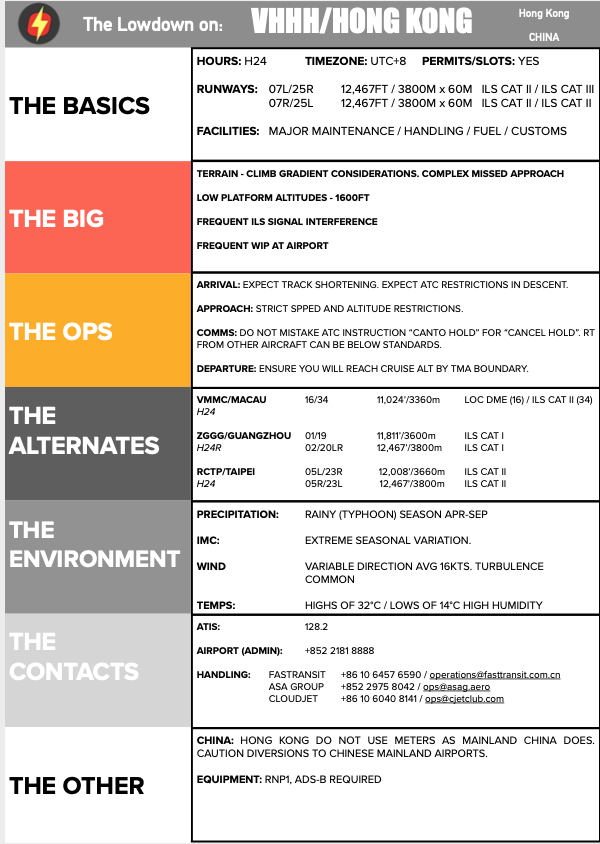
The Lowdowns look like this
Further Reading
- Here’s the article on how arrival and departure briefings might not be up to scratch, which sparked the lightbulb for us with our article.
More on the topic:
- More: Introducing: Airport Operational Lowdowns
- More: November Ops Chat
- More: Monday Briefing: Sinai Airspace avoided, Low Vis creates day of chaos
- More: Monday Briefing: Security in Caracas, Tripoli, UK Permit rules
More reading:
- Latest: More face scans at the US border: BizAv now included
- Latest: Mexico Customs Surprises: Pills, Vapes, and Laptop Rules
- Latest: Greenland NAT Alternates: Dec 2025 Update
- Safe Airspace: Risk Database
- Weekly Ops Bulletin: Subscribe
- Membership plans: Why join OPSGROUP?




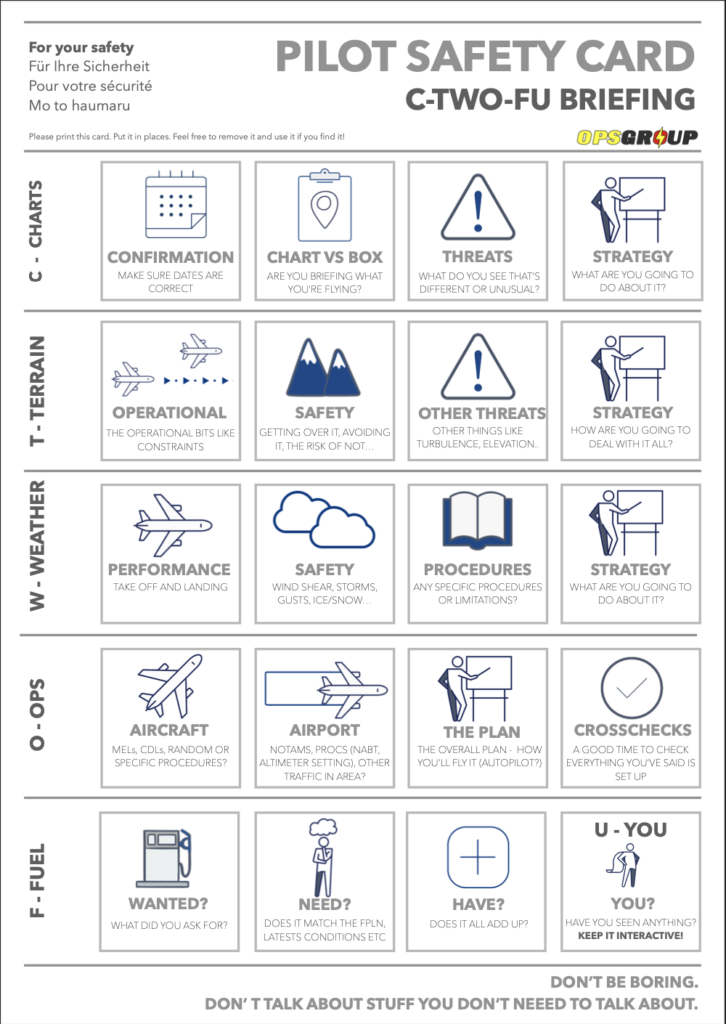







 Get the famous weekly
Get the famous weekly 



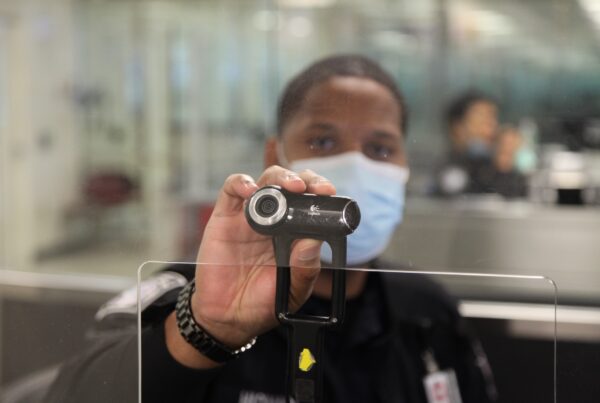


Awesome read. Thanks for the tip.
Excellent article, in a previous airline we used to use CTWO+ . Our current airline is adopting the Airbus briefing and it’s a positive move.
Having watched the new Airbus briefing format, I thought overall it’s a more interactive way of briefing, utilizing both crew members.
The part I didn’t like was whenever numbers were referenced, it appeared they were doing it all from memory, no one seemed to be looking at a chart. Not realistic after an all night flight.
Thank you Rebecca. A good read. I hope you are well.
Hey Rebecca , nice read ! If done ‘correctly’ the “C-TWO+“ is a great way to brief. Like the “F-U” addition in the article and not to forget the great infographic.
We’ve recently moved a ‘threat forward briefing’ too, gleaning from Alaska’s T-P-C , the new Airbus Brief and modified to our our own cultural context!
As long as we’re briefing ‘together’ , keeping it concise ,relevant, scalable and most importantly for ‘safety’ and not for the CVR, I think we’re all on the right path:)
Great read..
The “Lets cover everything” approach can make the “brief” long, boring and dangerous…
The art is to spot the main points and put the right light on them – exactly like this reading suggests.
Thank you Rebecca for another wonderful, to the point with the right amount of good humor article!
Looking forward to the next one.
Very good tips for any kind of aviators !